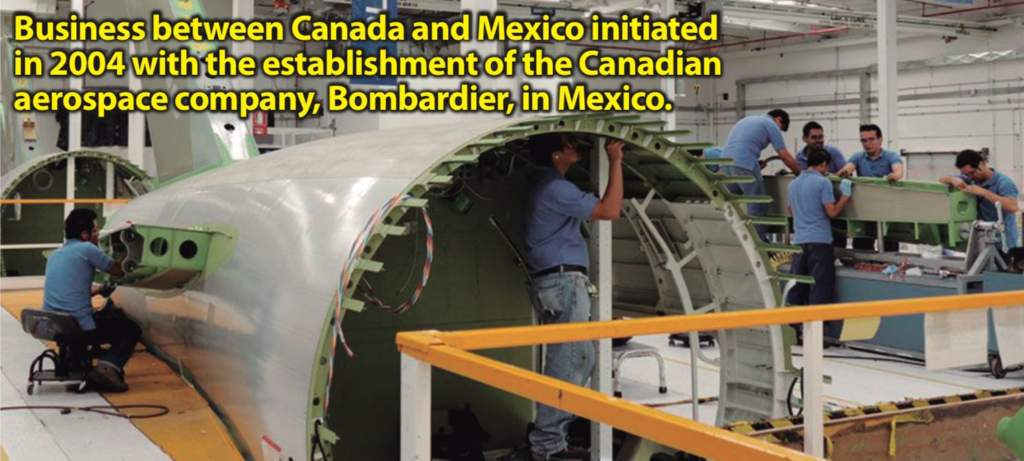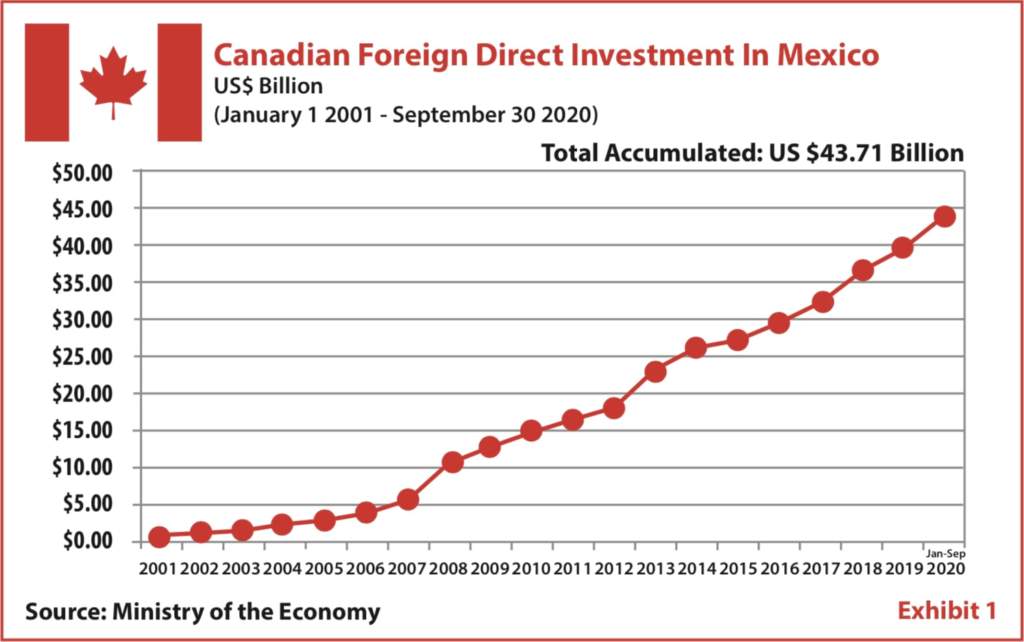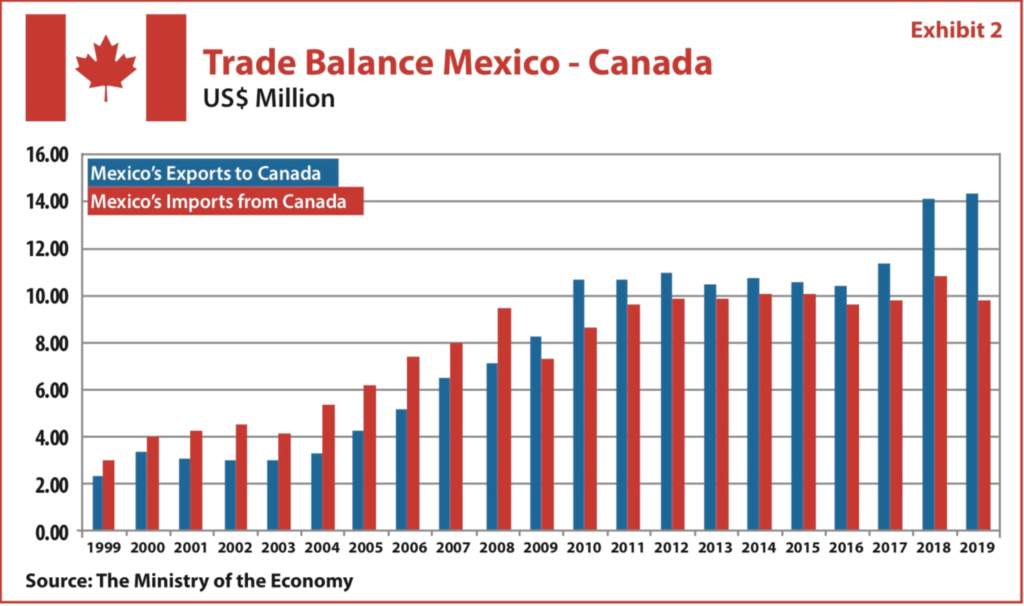Canada in Mexico

Warning: foreach() argument must be of type array|object, bool given in /home/mexiconow/public_html/sites/mexiconow/wp-content/themes/mexiconowwpnew/single.php on line 254
By Arturo Chretin
Mexico and Canada, along with the United States, have generated one of the most important commercial blocks in the world. Together, they have achieved the integration and value chain of the most developed industries worldwide and the North American region is an example of diplomatic, migratory and economic collaboration for the rest of the world. Focused on collaboration within North America, Mexico and Canada have worked closely with their common neighbor, the United States, sharing a vibrant and multifaceted relationship, which has been characterized by deep interpersonal ties, intense cultural connections, and increased trade and investment.
The main business sectors between Canada and Mexico that have greater potential for growth include:
• Aerospace
• Mining
• Oil and gas
• Agriculture, food and beverages
The historical, commercial and political trilateral alliance that these two countries have forged is mainly due to NAFTA, and now the USMCA—a successful treaty that positions North America as the largest economic zone in the world. However, there are also other types of agreements that involve these countries.
Economic and Political Integration
On July 1, 2020, the United States-Mexico-Canada Agreement (USMCA) entered into force. Signed on the margins of the G20 Leaders’ Summit in Buenos Aires in November 2018, the USMCA preserves key elements of the long-lasting trading relationship and incorporates new and updated provisions that seek to address 21st-century trade issues and promote opportunities for the nearly half a billion people who call North America home.
Unlike NAFTA, the USMCA encourages an increase in the production of cars and trucks, in addition to increasing environmental and labor regulations, among other things. This new agreement includes an area of 489 million inhabitants and a GDP (Gross Domestic Product) per capita of around US$49.000. Mexico and Canada displaced
China as the main trade partners of the United States in 2019.

In 1994, the United States, Mexico and Canada created the largest free trade region in the world with the North American Free Trade Agreement (NAFTA), generating economic growth and helping to raise the standard of living for the people of all three countries. By strengthening the rules and procedures governing trade and investment, this agreement has proved to be a solid foundation for building Mexico and Canada’s prosperity and has set a valuable example of the benefits of trade liberalization for the rest of the world.
The former NAFTA eliminated already most tariffs on products traded between the three countries, with a major
focus on liberalizing trade in agriculture, textiles, and automobile manufacturing. Since its implementation, NAFTA
benefited the economy through increasing overall trade to over US$1 trillion between the three countries. The new agreement will serve to reinforce the strong economic ties between Canada and Mexico, along with the United States.
Strategic Sectors
In the aerospace sector, business between Canada and Mexico initiated in 2004 with the establishment of the Canadian aerospace company, Bombardier, in Mexico. This later sparked international interest towards the potential of the aerospace sector in Mexico. Since then, the Mexican government has included aerospace as a priority sector for the country’s economic development.
In 2018, 93% of Canadian aerospace manufacturing firms were exporters, and Mexico was one its top exporting markets. The Mexican government has launched several programs to develop this sector, thus facilitating aerospace business between Canada and Mexico.
Mexico has become one of the most prominent players in the global aerospace industry. Aerospace manufacturing in Mexico now produces everything from engines, to cargo doors, fuselages, engine parts, landing gear assemblies, connection systems and a myriad of other components that are essential for an aircraft to function.
When Bombardier announced an aerospace engineering and manufacturing plant in Queretaro, many Canadian companies decided to move to Mexico, and suppliers and other manufacturers followed. In addition, on May 29, 2008, Bombardier announced an investment of US$250 million to build its third and fourth plants in Querétaro in the Querétaro Aerospace Park, in order to carry out the installation of subassembly systems, manufacturing the carbon composite structure, electrical harnesses and wings for the Learjet 85 aircraft, which by now has been completely cancelled.
On October 24, 2011, the company announced an investment of US$50 million to build its fifth plant, located in the Queretaro Aerospace Park, in order to carry out the manufacture of the rear fuselage of the new Global 7000 business
jet and Global 8000 at its production plant in Querétaro.
The automotive industry in Mexico is one of the most developed and attractive to invest worldwide. The development of the automotive and auto parts sector in Mexico has brought foreign investment from around the world, and Canada is no exception.
Magna is the largest manufacturer of automotive components in Canada and one of the Canadian companies with the largest operating presence abroad. It has more than 30 manufacturing plants and two engineering, product and sales offices in seven states of the country: Sonora, Nuevo León, Coahuila, San Luis Potosí, Guanajuato, the state of Mexico and Puebla. Its growth and presence in Mexico have been constant: in 2011, the company made an investment of US$100 million in San Luis Potosí and in 2013 it opened two new plants in Coahuila. In 2015, it decided to open a new plant in Queretaro with an investment of US$135 million and the creation of more than 600 jobs.
Bombardier Recreational Products (BRP) announced that it is investing US$136 million in a plant for the production of 4-wheel vehicles in Ciudad Juárez, Chihuahua. Through a press release, the firm indicated that the plant is expected to be ready for operation in the fall of 2021.
This was the first investment announced in Mexico in the USMCA era, after it came into force. Scotiabank is the Canadian bank with the largest international presence, serving nearly 19 million customers in more than 55 countries around the world, in America, the Caribbean, Europe and Asia. In Mexico, it has become one of the largest financial institutions.
Business between Canada and Mexico in the mining sector remains strong. More than 50% of mining projects listed on the Mexican government’s website are run by Canadian companies. In addition, Canadian global mining footprint is the second greatest in Mexico. The best mining business opportunities exist for those companies that are able to work with other local partners through technology transfer, complementary product offerings or through offering niche high-tech products/services that are not already provided within the local market.

The Canadian mining company Agnico Eagle has operations in Chihuahua and Sonora and is a reflection of sustainable mining. It promotes programs in favor of the environment and leads afforestation and recycling campaigns. In addition, it dignifies the standard of living and wages of its workers and, as if that were not enough, it speaks and directly clarifies the doubts of the citizens.
Fortunately, the food import market in Mexico is large and easily accessible. In 2018, 5% of Canada’s globally traded processed agri-food and beverages (including seafood) were shipped to Mexico. The fact that most Canadian food products can enter Mexico duty-free eases business between Canada and Mexico. Top Canadian imports into Mexico include fresh hams, shoulders and cuts, fresh boneless beef, canola oil, malt and frozen French fries.
Facts and Statistics
Regarding direct investments of Canada in Mexico, the companies with Canadian participation in Mexico have materialized, according to the data of the Mexican Ministry of Economy (SE), investments have summed up to US$43.71 billion from January 2001 through the month of September 2020, as shown in Exhibit 1.
Exhibit 2 summarizes the Trade Balance between Mexico and Canada. It shows that commerce between the two countries reached its maximum level in 2018, with US$24.85 billion recorded in trade between the two countries.

The bilateral commerce has been positive for Mexico since 2009. Important factors in the trade balance between
Mexico and Canada are interesting. For instance, take the fact that during the 20- year time span from January
1999 to December 2019, total exports from Mexico to Canada increased from US$2.31 billion to US$14.08 billion. And at the same time, imports from Canada to Mexico also showed a more impressive growth from US$2.95 billion
(1999) to US$9.84 billion (2019). And another interesting detail is that in 2019 commerce stats (US$24.16 billion) decreased almost 3% over the data of 2018 (US$24.85 billion).
Conclusion
Canada and Mexico have great potential to continue strengthening their bilateral relationship. Mexican and Canadian companies have achieved great benefits thanks to the cooperation between both countries, and with the help of the treaties that they have signed in the North American Region.
There are important diplomatic issues to be resolved in the coming months, such as the different official positions on issues such as climate change, renewable energies and labor issues, which must be resolved according to the commitments agreed to in the USMCA.
Definitely, the new normal presented by the economic reconfiguration derived from the COVID-19 contingency, “Near Shoring” will present even more opportunities and advantages for investment and cooperation between both countries.





